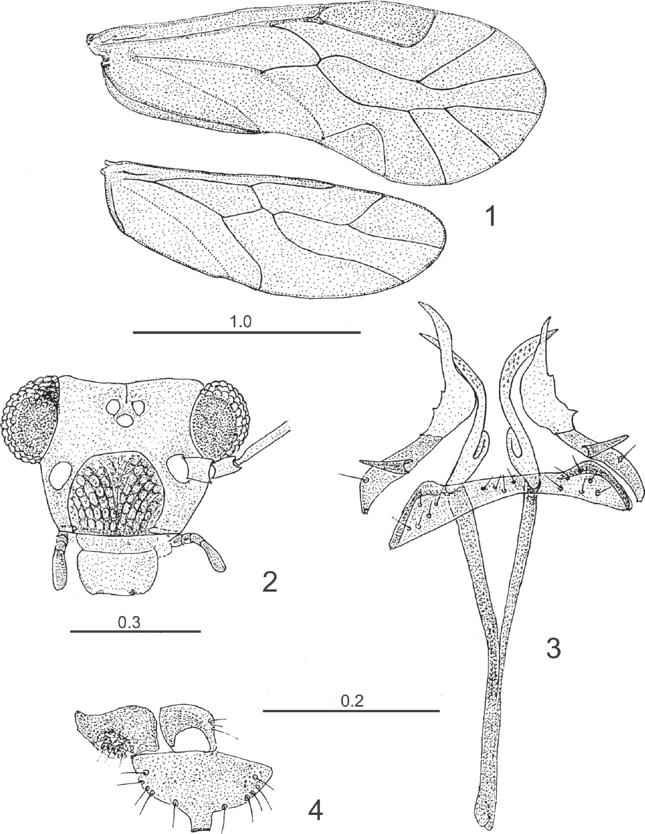INTRODUCTION
Species group Riegeli, of the genus Lachesilla, diagnosed by García-Aldrete (1974, 1982), and by Mockford (1993), is predominantly Neotropical, with three species ocurring in the United States, one species ocurring in the Galapagos Islands, and three species ocurring in the Greater Antilles. It presently includes ten species, five of which have been recorded in South America.
I recently found, in the Bolivian Chiquitania (Eastern Department of Santa Cruz), two males of Lachesilla that represent an undescribed species in species group Riegeli, constituting the first record of that group in Bolivia. The purpose of this paper is to describe that species, establish its affinities, and present an identification key to the species in the group.
MATERIAL AND METHODS
Two males were available for study, they were dissected in 80% ethanol, and their parts (head, right wings and legs and genitalia) were mounted in Canada balsam on slides. Standard measurements were taken on parts on the slides, utilizing a filar micrometer, with a measuring unit of 136 microns for wings and 53 microns for other parts. Abbreviations of parts measured are as follows: FW, HW: lengths of right fore- and hind- wings, F, T, t1 and t2: lengths of femur, tibia and tarsomeres 1 and 2 of right hindleg, Mx4: length of fourth segment of right maxillary palpus, ctt1: number of ctenidobothria on t1, f1…fn: lengths of flagellomeres 1…n of right antenna, IO, D and d respectively: minimum distance between compound eyes, antero-posterior diameter and transverse diameter of right compound eye, all in dorsal view of head, PO:d/D.
The types are deposited in the National Insect Collection (CNIN), Departamento de Zoología, Instituto de Biología, Universidad Nacional Autónoma de México, in Mexico City.
TAXONOMY
The males of Lachesilla in species group Riegeli are diagnosed as follows: Hypandrium one or two segmented. Clasper bases relatively slender, located on the sides of the hypandrium. Claspers single- or double- shafted, the shafts outcurved and distally pointed. Phallosome of single apodeme, dividing either before its middle, immediately beyond its middle, or near distal end, each branch producing an expanded area distally, joined to an outcurved pointed process of variable length. Paraprocts of two pieces, the proximal one bearing a sensory field, and the distal one bearing a mesal, hook tipped prong. Epiproct transverse, with single median, posteriorly directed process (García-Aldrete, 1974, 1982; Mockford, 1993).
Lachesilla chiquitana n. sp. Male

Figures 1-4 Lachesilla chiquitana García-Aldrete. Male. 1. Fore- and hind- wings. 2. Front view of head. 3. Hypandrium, phallosome and claspers. 4. Left paraproct and epiproct. Scales in mm. Figures 2 and 4 to common scale.
Diagnosis. It is the only species in species group Riegeli, in which the distal processes of the phallosome are of two arms, a short, distally rounded inner arm, and an elongate, distally pointed outer arm.
Color (in 80% ethanol). Body reddish brown. Compound eyes black, ocelli hyaline, without pigmented centripetal crescents. Maxillary palps dark brown. Antennae and legs pale brown. Wings almost hyaline, with a reddish brown hue. Veins reddish brown. Abdomen pale brown, with reddish brown subcuticular semi-rings on tergum and sides. Hypandrium and proximal halves of claspers reddish brown.
Morphology. Forewing Rs-M joined by a crossvein or fused for a distance. Pterostigma almost rectangular, wider distally; areola postica wide, apically rounded (Fig. 1). Hypandrium (Fig. 3) narrow, wider on sides, with postero-lateral corners slightly protruding. Phallosome (Fig. 3) with branches diverging about in the middle, each branch joined distally to a process of two arms, the inner one short, rounded distally, and the outer arm long, outcurved, distally pointed, bearing a field of microspines on distal half. Claspers on sides of hypandrium, proximal halves slender, elongate, each bearing mesally a directed outwards prong; distal halves outcurved, distally pointed, wider mesally (Fig. 3). Paraprocts (Fig. 4) with proximal half strongly sclerotized, sensory fields circular, with ten trichobothria on basal rosettes, and a marginal trichobothrium without basal rosette, distal half also sclerotized, bearing a long mesal prong. Epiproct wide (Fig. 4), with setae as illustrated, posterior process short, glabrous, distally truncate.
Measurements (in μm). FW: 1958, HW: 1509, F: 379, T: 708, t1: 226, t2: 89, ctt1: 17, Mx4: 85, f1: 201, f2: 177, f3: 159, f4: 128, f5: 94, IO: 289, D: 201, d: 130, IO/d: 2.22, PO: 0.64.
Material studied. Holotype male. BOLIVIA. Santa Cruz. 47 km N of San José Chiquitos, 323m., 17º24’11”S: 60º40’34”W, 23.I.2016, on dead leaves of cut down trees, A. N. García Aldrete. Paratype male. BOLIVIA. Santa Cruz. 43 km S of San Rafael, 331m., 17º07’34”S: 60º34’39” W, on dead leaves of shrubs, same date and collector as the holotype.
Etymology. The specific name refers to the area of origin of this species: the Chiquitania, in the Department of Santa Cruz, Bolivia.
Key to the males of Lachesilla in species group Riegeli
DISCUSSION
L. chiquitana is the first species of species group Riegeli to be recorded in Bolivia; other species of Lachesilla recorded in Bolivia are L. ariasi García Aldrete, and L. falcata García -Aldrete, in species group Forcepeta, and L. badonneli Williner, in species group Pedicularia. L. chiquitana is closest to L. paulista García -Aldrete, from Argentina and Brazil, with which it shares having a pointed process directed outwards, mesally in the proximal half of the claspers, and in having a field of microspines in the processes of the phallosome; it differs from it in having the processes of the phallosome of two arms, a short, rounded inner one, and a long, curved, acuminate outer arm, that bears a field of microspines.











 text new page (beta)
text new page (beta)



